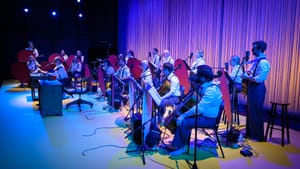Stay in the Loop
BSR publishes on a weekly schedule, with an email newsletter every Wednesday and Thursday morning. There’s no paywall, and subscribing is always free.
Maximal minimalists
#GLASSFEST and The Crossing present Donald Nally’s ‘Knee Plays’

Genuflecting to Philip Glass and David Byrne, The Crossing opened Annenberg Center’s #GLASSFEST on February 22 with the mysterious Knee Plays. A premiere, this devised work conceived and directed by Donald Nally boldly assayed dual icons of intellectual minimalism, meshing (and mashing) them together.
Knee Plays was crafted from the music of two seminal opera productions—Einstein on the Beach and the CIVIL WarS—both directed by the legendary Robert Wilson. Einstein (1976), an opera composed by Glass, has five “knee plays” framing and connecting its four acts. (A knee play, also called an entr’acte, was traditionally played in front of the stage curtain.)
A poetical meld
The CIVIL warS, a massive 1980s five-part 12-hour opera never performed in its entirety, was to have each section originated in a different city and written by a different composer, one of whom was Byrne. In 1985, Byrne released Music for The Knee Plays, a 12-track vinyl album of those compositions that was also presented in a 1984 performance-art version at the adventurous Walker Art Center in Minneapolis.
Byrne’s record and Glass’s Einstein were the basis for Nally’s 90-minute work, performed without intermission. The show poetically melds the music of these two composers, whose aims—exploring where music might take them—are similar but whose affect is totally different. Glass (Juilliard-trained) is aptly famed for the beauty and seduction of chantlike, mesmeric musical repetition. Byrne (front man for the legendary group Talking Heads) writes text-based songs that are poetic invocations of familiar things.
Impressive pastiche
Textually and musically, Nally’s synthesis proved intriguing and thought-provoking. The evening was verbally anchored by Dito van Reigersberg, listed as Orator, who moved between two old-fashioned wooden office desks, tossing aside papers as he read. The actor gave an estimable and charming performance, delivering Byrne’s intentionally confounding words (from pieces like “Social Studies” and “The Sound of Business”) with a gravitas winningly tempered by sly wit and occasional knowing nods to the performers arrayed around him.
Kevin Vondrak insightfully adapted Byrne’s own orchestrations (made with the composer’s express permission) and smoothly, almost imperceptibly, joined the two men’s music. As rehearsals began, members of The Crossing were asked to bring whatever instruments they played, so the band’s make-up was an unforeseen and unusual pastiche, making Vondrak’s work all the more impressive.
Uneven design
Whether it was purposeful in the sound design (by Paul Vazquez) or unintentional, the music sometimes eclipsed van Reigersberg’s words, with the singers seated in front of Eric Southern’s stage curtain (hundreds of thin threads) that he lit beautifully with changing colors.

In a sartorial nod to Byrne’s recent (and returning-in-the-fall) Broadway hit American Utopia—where his eclectic barefoot ensemble wore suits—The Crossing performers (also sans shoes) were dressed in white shirts and dark pants with suspenders. A costume-and-wigs change midway (a tribute to van Reigersberg’s drag career?) contributed little to the show’s impact, actually detracting from the forward motion.
Nally signatures
Of course, such an intimate production (in the Annenberg’s black-box Prince Theatre) couldn’t possibly carry the theatrical scope and force of its inspirations, nor was it meant to. It’s always exciting to be presented with a big idea in a small space, and this Nally production was no exception. Referential and reverential, the performance was both unexpected and predictable—and mystifying in ways that both excited and frustrated.
About 15 minutes before curtain-time, the 19 singers began to enter in an excruciatingly slow procession—a Nally signature than can be, as here, confusing to the audience. Some watched the performers; others (like those seated next to me) discussed at length their post-show dessert destination.
Predictably, The Crossing sang with impeccable intonation and consummate musicality. Unpredictably, according to the program, they also were “a band that perhaps should or should not be playing these instruments in public.” But no disclaimer was necessary. Sitting behind balloon-shaped bandstands (a shout-out to the big-band era), these performers were tight and joyful whether singing or playing. Their eclectic combo ranged from violins, cellos, oboes, and French horn to saxophones, flugelhorn, and cowbells in arrangements with some great riffs and swinging solos, especially for marvelous jazz trumpeter Michael Jones and for Nally himself, who played a mean baritone sax.
Aiming for questions
Will Knee Plays be remounted and added to The Crossing’s nascent but growing performance repertoire? This was just one question that the production raised, without an answer—clearly an aim of this enigmatic, intriguing work built on the music of two contemporary masters.
What, When, Where
Knee Plays. Conceived and directed by Donald Nally, from the music of Philip Glass and David Byrne. A presentation of #GLASSFEST. February 21 and 22, 2020 at The Annenberg Center’s Harold Prince Theatre, 3680 Walnut Street, Philadelphia. (215) 898-3900 or annenbergcenter.org.
The Annenberg Center accommodates the needs of individuals with physical disabilities. Details are available online. The Annenberg has a gender-neutral restroom.
Sign up for our newsletter
All of the week's new articles, all in one place. Sign up for the free weekly BSR newsletters, and don't miss a conversation.

 Gail Obenreder
Gail Obenreder